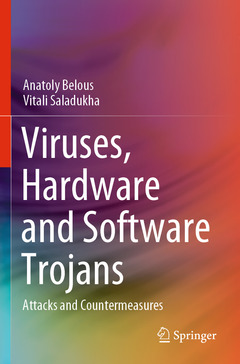Description
Viruses, Hardware and Software Trojans, 1st ed. 2020
Attacks and Countermeasures
Authors: Belous Anatoly, Saladukha Vitali
Language: English
Subjects for Viruses, Hardware and Software Trojans:
Approximative price 116.04 €
In Print (Delivery period: 15 days).
Add to cartPublication date: 06-2021
822 p. · 15.5x23.5 cm · Paperback
Approximative price 158.24 €
In Print (Delivery period: 15 days).
Add to cartPublication date: 06-2020
822 p. · 15.5x23.5 cm · Hardback
Description
/li>Contents
/li>Biography
/li>Comment
/li>
Introduction.- Information weapon: concepts, means, methods and examples of application.- Computer Viruses, Malicious Logic and Spyware.- Hardware Trojans in Electronic Devices.- Hardware Trojans in Microcircuits.- Methods of Identification of Hardware Trojans in Integrated Circuits.- Reverse Engineering of Integrated Circuits.- Methods of counteracting hardware IC Trojans.- Is the Trojan phenomenon a new stage in the evolution of modern weapons?.
Anatoly Belous graduated from the Minsk Radio-Technical University, with a specialty in Electronic Engineering in 1973. Presently he is Deputy CEO on Science of “INTEGRAL’ Holding (Minsk, Republic of Belarus). He is Doctor of Technical Sciences, Professor Member of the National Academy of Sciences of the Republic of Belarus, Academician, Laureate of the State Award of the Republic of Belarus, Meritorious Inventor of the Republic of Belarus. He is also a member of the Editorial Boards of four science journals, Chairman of the State Experts Council of the Republic of Belarus on microwave electronics, photonics, micro- and nano-electronics. He is Deputy Chairman of the Program-Drafting Committee of two International Annual Conferences on Microelectronics. For a number of years, he conducted the special courses of lectures on the electronics in the technical universities of Russia, Belarus, China, India, France, Germany, Israel, Austria, Bulgaria, Vietnam, Poland, the Ukraine. He delivers the regular reports on the electronics at the conferences, seminars and working meetings in the Russian State Space Corporation “Roskosmos”. He is the author of over 400 publications, a holder of over 200 patents, possesses over 30 monographs and manuals.
Vitali Solodukha obtained his Ph. D. from the Faculty of Radio-Physics and Electronics of the Belarusian State University (Minsk) in 1980. Presently he is the CEO of “INTEGRAL’ Holding (Minsk, Republic of Belarus). He is the author of more than 100 publications, 8 books, Laureate of the State Award of the Republic of Belarus, Laureate of the Award of the Ministry of Industry of the Republic of Belarus. He is Research Supervisor of joint Russian-Belarussian projects on micro-nanoelectronics, thermal imaging equipment and automobile electronics. Dr. Solodukha is also the Supervisor of national program “Microelectronics” of the Republic of Belarus, a member of Expert Board at the Ministry of Industry of the Republic of Belarus
Describes the evolution of hardware Trojans from "cabinets", "boxes" and "cases" to advanced circuits
Discusses both software and hardware Trojans, the principles of their design, the mechanisms of functioning, the methods of detection, the methods of masking them, the methods of prevention and protection
Presents complex topics using simple language, minimizing mathematics




